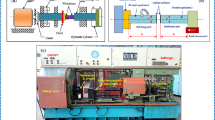Abstract
This paper aims at exploring how tool path strategies influence the friction and wear behavior of high-speed ball-end-milled hardened AISI D2 steel. High-speed hard milling (HSHM) operations were conducted on a 5-axis machining center with three different tool path strategies. Dry sliding friction and wear tests of test samples versus GCr15 rings were performed utilizing a block-on-ring tester. Results showed that friction and wear behavior were closely associated with tool paths. Though the same cutting parameters were used, there is a numerical evidence on the difference in surface integrity for different tool path conditions. Low friction coefficient was obtained for surfaces with microgroove orientation perpendicular to sliding direction. Inclination extent of grain boundary can act as a wear resistance indicator. The subsurface softening degree is the most evident factor by which tool paths influence wear behavior. It determines the way of carbide spalling and the severity of plastic deformation and then the main wear mechanisms. This study indicates that the friction and wear performance of ball-end-milled surfaces suffering from known friction loads can be improved by appropriate selection of tool path strategies.
Similar content being viewed by others
References
Tang LH, Gao CX, Huang JL, Zhang HY, Chang WC (2013) Dry sliding friction and wear behaviour of hardened AISI D2 tool steel with different hardness levels. Tribol Int 66:165–173
El-Wardany TI, Kishawy HA, Elbestawi MA (2000) Surface integrity of die material in high speed hard machining, part 1: micrographical analysis. J Manuf Sci Eng 122(4):620–631
Koshy P, Dewes RC, Aspinwall DK (2002) High speed end milling of hardened AISI D2 tool steel (∼ 58 HRC). J Mater Process Technol 127(2):266–273
Kang MC, Kim KK, Lee DW, Kim JS, Kim NK (2001) Characteristics of inclined planes according to the variations of cutting direction in high-speed ball-end milling. Int J Adv Manuf Technol 17(5):323–329
Neto HK, Diniz AE, Pederiva R (2016) Tool life and surface roughness in the milling of curved hardened-steel surfaces. Int J Adv Manuf Technol 87(9–12):2983–2995
Fallböhmer P, Rodrı́guez CA, Özel T, Altan T (2000) High-speed machining of cast iron and alloy steels for die and mold manufacturing. J Mater Process Technol 98(1):104–115
Tang L, Yin J, Sun Y, Shen H, Gao C (2017) Chip formation mechanism in dry hard high-speed orthogonal turning of hardened AISI D2 tool steel with different hardness levels. Int J Adv Manuf Technol 93:2341–2356
Huang W, Zhao J, Xing A, Wang G, Tao H (2018) Influence of tool path strategies on fatigue performance of high-speed ball-end-milled AISI H13 steel. Int J Adv Manuf Technol 94(1–4):371–380
Lakshmipathy R, Sagar R (1992) Effect of die surface topography on die-work interfacial friction in open die forging. Int J Mach Tools Manuf 32(5):685–693
Menezes PL, Kumar K, Kailas SV (2009) Influence of friction during forming processes-a study using a numerical simulation technique. Int J Adv Manuf Technol 40(11–12):1067–1076
Magri ML, Diniz AE, Button ST (2013) Influence of surface topography on the wear of hot forging dies. Int J Adv Manuf Technol 65(1–4):459–471
Resendiz J, Graham E, Egberts P, Park SS (2015) Directional friction surfaces through asymmetrically shaped dimpled surfaces patterned using inclined flat end milling. Tribol Int 91:67–73
Denkena B, Kästner J, Wang B (2010) Advanced microstructures and its production through cutting and grinding. CIRP Ann Manuf Technol 59(1):67–72
Yuan S, Huang W, Wang X (2011) Orientation effects of micro-grooves on sliding surfaces. Tribol Int 44(9):1047–1054
Yasavol N, Ramalho A (2015) Wear properties of friction stir processed AISI D2 tool steel. Tribol Int 91:177–183
Singh K, Khatirkar RK, Sapate SG (2015) Microstructure evolution and abrasive wear behavior of D2 steel. Wear 328–329:206–216
Bourithis L, Papadimitriou GD, Sideris J (2006) Comparison of wear properties of tool steels AISI D2 and O1 with the same hardness. Tribol Int 39(6):479–489
Torkamani H, Raygan S, Rassizadehghani J (2014) Comparing microstructure and mechanical properties of AISI D2 steel after bright hardening and oil quenching. Mater Des 54:1049–1055
Ko TJ, Kim HS, Lee SS (2001) Selection of the machining inclination angle in high-speed ball end milling. Int J Adv Manuf Technol 17(3):163–170
Chen X, Zhao J, Zhang W (2015) Influence of milling modes and tool postures on the milled surface for multi-axis finish ball-end milling. Int J Adv Manuf Technol 77(9–12):2035–2050
Li W, Guo YB, Guo C (2013) Superior surface integrity by sustainable dry hard milling and impact on fatigue. CIRP Ann Manuf Technol 62(1):567–570
Javidi A, Rieger U, Eichlseder W (2008) The effect of machining on the surface integrity and fatigue life. Int J Fatigue 30(10–11):2050–2055
Kim DE, Cha KH, Sung IH, Bryan J (2002) Design of surface microstructures for friction control in micro-systems applications. CIRP Ann Manuf Technol 51(1):495–498
Saghafian H, Kheirandish S (2007) Correlating microstructural features with wear resistance of dual phase steel. Mater Lett 61(14):3059–3063
Hanesch M (2009) Raman spectroscopy of iron oxides and (oxy) hydroxides at low laser power and possible applications in environmental magnetic studies. Geophys J Int 177(3):941–948
Fabis P, Heidersbach R, Brown C, Rockett T (1981) Oxide scale formation on iron-chromium alloys in elevated temperature air environments. Corrosion 37(12):700–711
Das D, Dutta AK, Ray KK (2009) Correlation of microstructure with wear behaviour of deep cryogenically treated AISI D2 steel. Wear 267(9):1371–1380
Funding
This work was supported by the Science and Technology Development Program of Shandong Province (2014GGX103041), in China.
Author information
Authors and Affiliations
Corresponding author
Rights and permissions
About this article
Cite this article
Huang, W., Zhao, J., Ai, X. et al. Influence of tool path strategies on friction and wear behavior of high-speed ball-end-milled hardened AISI D2 steel. Int J Adv Manuf Technol 96, 2769–2779 (2018). https://doi.org/10.1007/s00170-018-1774-7
Received:
Accepted:
Published:
Issue Date:
DOI: https://doi.org/10.1007/s00170-018-1774-7




